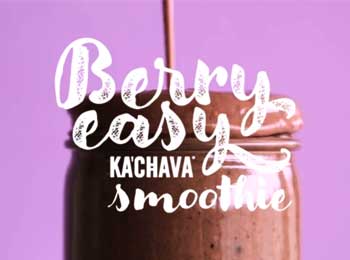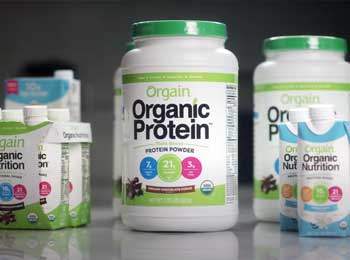Plant-based protein powders like Ka’Chava and Orgain have become increasingly popular among health-conscious consumers looking to cut down on meat and boost their protein intake from vegetarian sources. But with so many options on the market, how do you decide which one is right for you?
Here we’ll compare the pros, cons, ingredients, nutrition, cost, taste and more between these two leading plant-based protein brands.
A Brief Comparison Table
| Aspects | Ka’Chava | Orgain |
| Protein per Serving | 26g | 21g |
| Calories per Serving | 230 | 150 |
| Carbs per Serving | 24g | 15g |
| Fat per Serving | 6g | 5g |
| Fiber per Serving | 7g | 5g |
| Taste | Thick, sweet, tropical fruit flavor. More polarized reviews. | Smoother, neutral flavor, milk-like taste. More agreeable taste. |
| Cost | $16.58 per bottle or $85-$150 per tub. More expensive. | $24 for 12 bottles or $27-$36 per tub. More budget-friendly. |
| Ingredients | 52 superfoods like chia, hemp, goji, acai, spirulina, etc. More exotic. | Pea protein, brown rice protein, chia, hemp. More common ingredients. |
| Texture | Very thick and milkshakey. | Relatively smooth and drinkable. |
| Dietary Restrictions | Dairy-free, soy-free, gluten-free, non-GMO. Contains xanthan gum and natural flavors. | Dairy-free, soy-free, gluten-free, non-GMO. No artificial ingredients. |
| Micronutrients | Higher antioxidants from superfruits. | Has added probiotics and digestive enzymes. |
Ka’Chava Overview
Ka’Chava is a nutritional shake made from a proprietary blend of fruits, vegetables, seeds, nuts and plant proteins. It was formulated by Dr. Emil Hodzovic in 2014 as a plant-based, dairy-free, soy-free, gluten-free and non-GMO complete meal replacement shake.
Some of the key ingredients in Ka’Chava include:

- Pea protein
- Chia seeds
- Hemp seeds
- Amaranth
- Goji berries
- Camu camu
- Acai puree
- Flaxseed
- Quinoa
- Chlorella
- Spirulina
- Prebiotics and probiotics
Ka’Chava contains a whopping 52 superfoods crammed into each serving. It comes in both ready-to-drink bottles and canisters of powder to mix at home.
The company markets it as a nutritionally complete meal replacement packed with vitamins, minerals, omega-3s, antioxidants, protein and fiber. Ka’Chava promises to boost energy, accelerate weight loss, build lean muscle, support immune function and enhance overall health.
Orgain Overview
Orgain was created by Dr. Andrew Abraham after he underwent chemotherapy treatment for cancer. He wanted a clean, organic protein powder to help him regain strength and energy.
Some of Orgain’s primary protein sources include:
- Pea protein
- Brown rice protein
- Chia seeds
- Hemp protein
Beyond protein, Orgain features many nutrient-dense ingredients like organic acacia fiber, probiotics, fruits and vegetables. They offer a range of protein powders to support different health goals like building muscle, slimming down or simply adding more protein to your diet.
Orgain aims to provide plant-based, gluten-free, soy-free, kosher and non-GMO protein products with organic ingredients and no artificial flavors or sweeteners.
Also Read: Comparison Between Ka’chava And Vega
Key Comparison Between Ka’Chava and Orgain
Nutrition Comparison
Both Ka’Chava and Orgain offer complete, vegan protein powders with lots of superfoods and nutrient-dense ingredients. Let’s see how they stack up against one another nutritionally:
Per serving:
| Nutrient | Ka’Chava | Orgain |
| Calories | 230 | 150 |
| Protein | 26g | 21g |
| Carbs | 24g | 15g |
| Fat | 6g | 5g |
| Fiber | 7g | 5g |
Ka’Chava is higher in protein, calories, carbs and fiber compared to Orgain.
Both provide a hefty dose of vitamins and minerals. Ka’Chava has the edge when it comes to antioxidant content with its blend of superfruits like acai and goji berries.
For protein sources, Orgain contains pea, brown rice and hemp while Ka’Chava has pea, hemp and chia. Both use easily digestible, plant-based proteins.
When it comes to probiotics and digestive enzymes, Orgain has added probiotics (Lactobacillus acidophilus) and digestive enzymes. Ka’Chava does not contain probiotics or enzymes.
So in terms of nutrition profile, Ka’Chava is packed with more protein, calories and superfoods while Orgain offers probiotics and enzymes.
Taste
Since taste is subjective, here’s a brief rundown of how Ka’Chava and Orgain protein powders are commonly described:

Ka’Chava has a very thick, milkshake-like texture. The taste is often described as berry or tropical fruit flavored. Some find it incredibly delicious and almost addictive while others say it’s too thick and sweet.
Orgain has a smoother, less thick texture that’s easier to drink. It has light creaminess and a mild flavor. The taste is relatively neutral but often compared to vanilla or chocolate milk. Most agree it tastes pleasant and agreeable.
So in summary, Ka’Chava seems to have more polarized reviews when it comes to taste – people either love it or hate it, while Orgain has more consistently positive feedback for having an inoffensive, mildly sweet taste and smooth drinkability.
Cost Comparison
Both Ka’Chava and Orgain offer a few different purchasing options. Let’s break down the costs:
Ka’Chava
- 12 Pack Bottles: $199 ($16.58 per bottle)
- Canisters: $85-$150
Orgain
- Tubs: $27-$36 for 2 lbs
- Bottles: $24 for 12 pack
For the ready-to-drink bottles, Orgain is about $8 cheaper per package than Ka’Chava.
When it comes to the powder canisters or tubs, Orgain still comes in at around half the price per pound compared to Ka’Chava.
Across the board, Orgain is clearly the more budget-friendly option in terms of upfront costs. However, fans of Ka’Chava argue that it offers more complete daily nutrition so the higher cost is justified.
Pros and Cons
Ka’Chava Pros
- Packed with superfoods and antioxidants
- Higher in protein, calories and fiber
- Thick, milkshake-like texture
- Tropical berry flavor often described as delicious
Ka’Chava Cons
- Expensive
- Contains xanthan gum and artificial flavors
- Texture and taste not preferred by some
- Lacks probiotics and enzymes
Orgain Pros
- More budget-friendly
- Contains probiotics and enzymes
- Smooth, drinkable texture
- Relatively neutral taste appeals to most
- Organic ingredients
Orgain Cons
- Less protein, calories and fiber than Ka’Chava
- Not as nutrient-dense
- Some don’t like the rice protein taste
- Lower superfood profile
Watch This Review Video:
Which is Better for You?
There is no definitive “winner” here as both Ka’Chava and Orgain are quality protein powders with their own sets of pros and cons. Here are some factors to consider when choosing between them:
For Weight Loss: Ka’Chava may be slightly better suited for weight loss owing to its higher protein and fiber content which helps suppress appetite and reduce calorie intake throughout the day.
For Building Muscle: Ka’Chava wins again here with more protein per serving to support muscle protein synthesis. The higher calorie load also makes it advantageous for bulking up.
For Nutrient Density: Ka’Chava contains three times more superfoods and antioxidants from its long list of exotic ingredients.
For Taste Preference: This one comes down to personal opinion. If you want an ultra-thick, sweet shake texture, Ka’Chava is likely more appealing. If you prefer a lighter, more neutral taste then Orgain may suit you better.
For Dietary Restrictions: Both contain no major allergens like dairy, gluten or soy. Ka’Chava contains some artificial flavors while Orgain is all natural. If you’re sensitive to additives, Orgain may be the better choice.
For Affordability: Orgain is clearly easier on the wallet for anyone on a tight budget. Ka’Chava does offer a 30-day money back guarantee though.
For Convenience: Both come ready-to-drink for on-the-go protein when you don’t have time to mix.
At the end of the day, it depends most on your individual needs, preferences, and budget. Hopefully breaking down the nutrition facts, ingredients, cost, taste, and pros and cons for each provides a helpful guide to deciding between Ka’Chava versus Orgain!
Also Read: Battle of electrolyte powder-Drip Drop Vs. LMNT
Frequently Asked Questions
Some potential side effects of Ka’Chava reported by certain users include:
Bloating or stomach discomfort: Likely from the high fiber content. Hypersensitivity reactions: Possibly linked to the various superfood ingredients. Increased thirst: Ka’Chava does not contain much fluid so may lead to dehydration. Weight gain: If consuming excess calories beyond your needs. Spiking blood sugar: Contains 24g carbs so could spike blood sugar in diabetics. Artificial flavors: Xanthan gum and natural flavors are not truly natural. Of course results vary person to person. Starting with smaller servings and consulting a doctor is advised if any negative effects occur.
Ka’Chava is packed with an impressive array of superfoods high in antioxidants and nutrients. However, some nutrition experts argue the quantity of exotic ingredients is more of a marketing ploy than delivering proven health benefits.
Some ingredients like spirulina and chlorella are not sufficiently studied to confirm their proposed benefits. And real whole foods are likely healthier than extracted superfood powders.
So while Ka’Chava is healthy compared to fast food, it should not replace a diet high in vegetables, fruits and whole foods. Moderation is key even when consuming seemingly healthy protein powders.
Drinking plant-based protein like Orgain every day is likely safe and healthy for most people. Getting extra protein from sources like peas, brown rice and hemp can be an excellent addition to a balanced diet.
The FDA recommends 0.8 grams of protein per kilogram of body weight per day. Endurance athletes often need 1.2-2.0 grams. As long as overall calorie intake remains moderate, an organic protein drink per day is perfectly fine.
Of course, variety is important so be sure to get protein from whole food sources like beans, lentils, nuts and seeds as well. And consult your healthcare provider with any concerns.
Compared to other protein powders on the market, Orgain is priced very competitively and considered affordable by most consumers. Some of the factors that keep Orgain’s costs lower include:
Simpler ingredients list: Not as many exotic or trendy superfoods. Use of rice protein: Rice protein from brown rice is usually cheaper than plant proteins like pea. Economies of scale: As a mature company they likely get better bulk pricing on ingredients. Orgain also frequently offers coupon codes and discounts on their website which further reduces costs. Given the price per serving compared to other plant-based and organic protein powders, Orgain offers excellent value at a budget-friendly price point.
Also Read: Is Ascent Better Than Optimum Nutrition?
The Bottom Line
Both Ka’Chava and Orgain make excellent options for plant-based, dairy-free, gluten-free and non-GMO complete protein powders.
Ka’Chava stands out for its ultra-dense nutrition profile packed with a long list of trendy superfoods. But it comes at a steep price and some find the taste and texture too extreme.
Orgain takes a more simplified approach with easier to drink nutrition focused on protein, fiber and probiotics. And does so at a notably cheaper price point for budget-conscious consumers.
There are valid reasons to choose either brand depending on your specific nutritional needs and preferences. Hopefully this detailed comparison of Ka’Chava and Orgain gives you the knowledge to decide which plant-based protein powder is the right choice for you!

